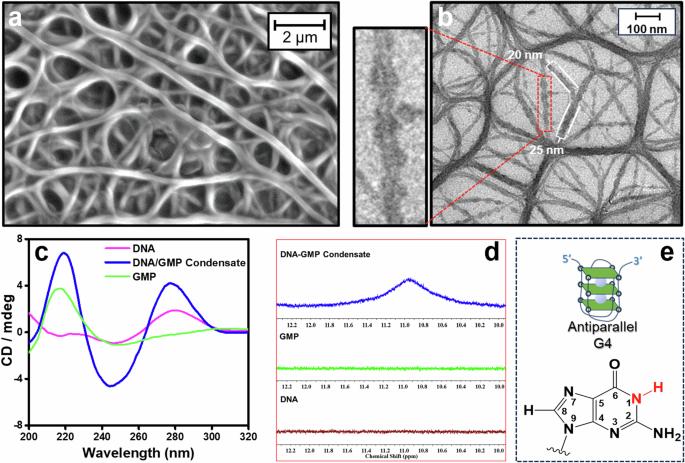受染色质启发,生物质 DNA 与单磷酸鸟苷之间的生物缩合产生了全核苷水凝胶,可作为亲水性药物载体
IF 6.2
2区 化学
Q1 CHEMISTRY, MULTIDISCIPLINARY
引用次数: 0
摘要
生物分子与超分子纳米结构的结合构成了自然界的基础。自然发生的液-液相分离产生的生物分子缩合物启发了多维应用的生物分子智能材料的形成。生物质 DNA 和单磷酸鸟苷(GMP)之间的非共价生物缩合已经得到描述,这种缩合模仿染色质折叠,形成了独特的 "全核 "DNA-GMP 缩合物。这些凝聚物开始形成基于 G-四链的超结构,在协同氢键和堆叠的驱动下组装成超螺旋纤维,并对其进行了深入研究。这种简单的生物质 DNA 生物缩合一步法可产生一种 "全核 "水凝胶,具有高阶自组装和优异的机械性能。大多数已报道的基于 DNA 的生物材料(包括水凝胶)都需要精确排序和分子结构化的 DNA 构建模块,而我们已经开发出一种简单、通用和方便的生物缩合方法,利用从任何生物资源中获取的生物质 DNA 来制造 DNA 水凝胶。这种水凝胶能有效地包裹和维持亲水性和疏水性药物的释放,证明了其作为药物载体的能力。我们相信,这种高能效、低成本的方法代表了一种利用生物 DNA 作为下一代软材料构件的新技术。生物分子凝聚物为一系列应用提供了有用的平台。在这里,作者描述了生物质 DNA 与单磷酸鸟苷之间的非共价生物缩合,模仿染色质折叠,创造出全核水凝胶,作为疏水性和亲水性药物的载体。本文章由计算机程序翻译,如有差异,请以英文原文为准。

Chromatin inspired bio-condensation between biomass DNA and guanosine monophosphate produces all-nucleic hydrogel as a hydrotropic drug carrier
The integration of biomolecules into supramolecular nanostructures forms the basis of the natural world. Naturally occurring liquid-liquid phase separation resulting in biomolecular condensates has inspired the formation of biomolecule-based smart materials with multi-dimensional applications. A non-covalent bio-condensation between biomass DNA and guanosine monophosphate (GMP) has been described, mimicking chromatin folding and creating a unique “all-nucleic” DNA-GMP condensates. These condensates initiate the formation of G-quadruplex-based superstructures, assembling into super-helical fibres driven by synergistic hydrogen bonding and stacking, which have been thoroughly investigated. This simple, one-step method for the bio-condensation of biomass DNA leads to an “all-nucleic” hydrogel with higher-order self-assembly and excellent mechanical properties. While most of the reported DNA based biomaterials, including hydrogels, require precisely sequenced and molecularly architectured DNA building blocks, we have developed a simple, universal, and facile bio-condensation method that utilizes biomass DNA acquired from any bio-resource to fabricate DNA hydrogels. The hydrogel efficiently encapsulates and sustains the release of both hydrophilic and hydrophobic drugs, demonstrating its competency as a drug carrier. We believe this energy-efficient and low-cost method represents a new technique for using biomass DNA as building blocks for the next generation of soft materials. Biomolecular condensates provide a useful platform for a range of applications. Here, the authors describe a non-covalent bio-condensation between biomass DNA and guanosine monophosphate, mimicking chromatin folding and creating an all-nucleic hydrogel as a carrier for both hydrophobic and hydrophilic drugs.
求助全文
通过发布文献求助,成功后即可免费获取论文全文。
去求助
来源期刊

Communications Chemistry
Chemistry-General Chemistry
CiteScore
7.70
自引率
1.70%
发文量
146
审稿时长
13 weeks
期刊介绍:
Communications Chemistry is an open access journal from Nature Research publishing high-quality research, reviews and commentary in all areas of the chemical sciences. Research papers published by the journal represent significant advances bringing new chemical insight to a specialized area of research. We also aim to provide a community forum for issues of importance to all chemists, regardless of sub-discipline.
 求助内容:
求助内容: 应助结果提醒方式:
应助结果提醒方式:


